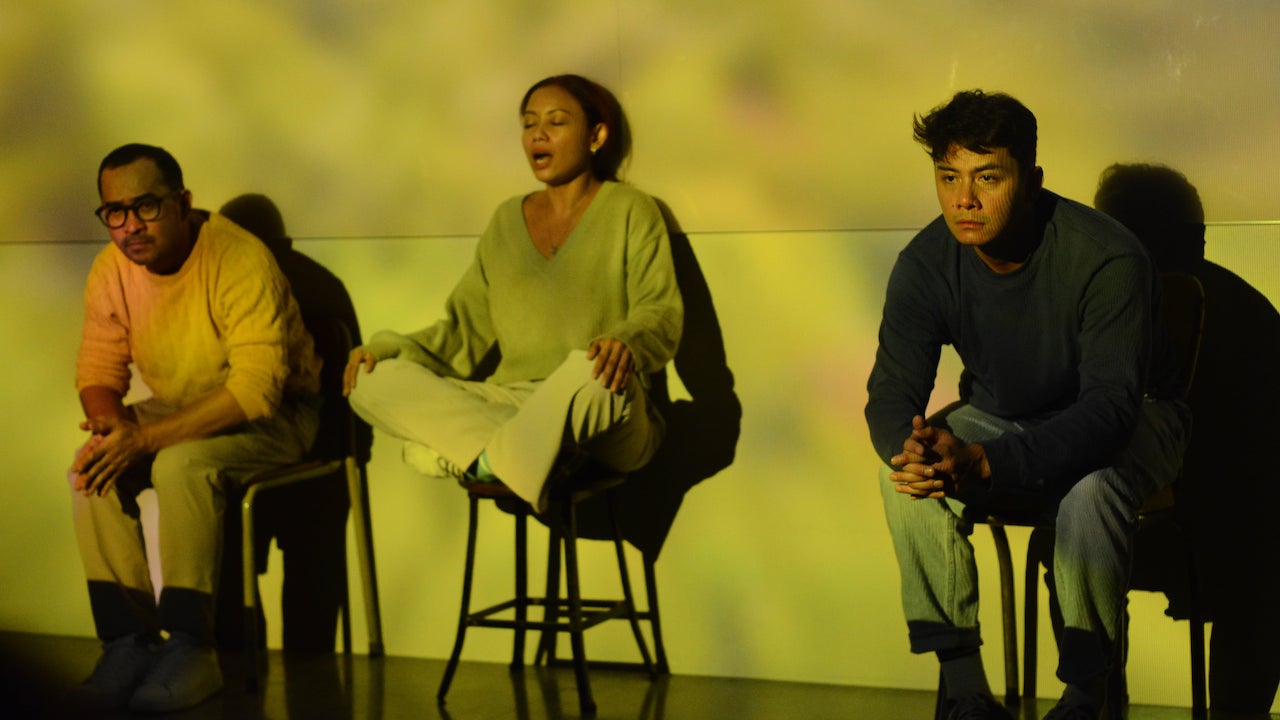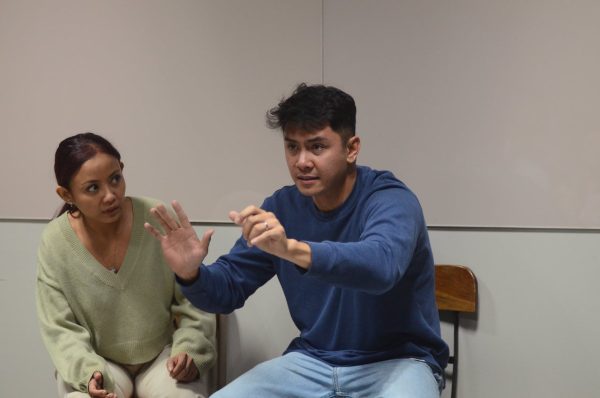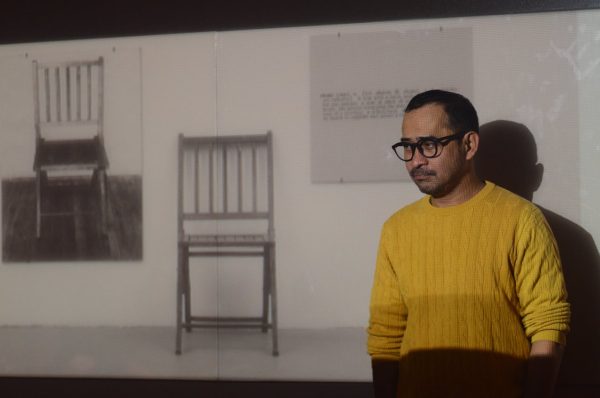
REVIEW: ‘3 Upuan’ is an extraordinary study of the purpose of grief
The stunning new play from playwright and director Guelan Varela-Luarca is an in-depth exploration of how human beings construct meaning in the face of loss.
Grief doesn’t get any easier to talk about, no matter how many stories are written about it. That it remains such a prevalent narrative theme is probably a sign that no one has truly figured out how to come to terms with it—but that attempting to do so still remains an urgent, universal experience. Aréte and Scene Change’s new production of 3 Upuan (originally staged in 2024) continues this inquiry into the phenomenon of grief, then keeps following the rabbit hole down to places even stranger and even more deeply therapeutic.
Staged in a confined space with only three actors, three chairs, and a host of projected images, the nonlinear play observes three adult siblings coming together as their father lies in critical condition at the hospital. And it is, simply put, extraordinary work. Between its three profoundly affecting performers, its intelligent deconstruction of what even constitutes the reality of our grieving, and direction that fully demonstrates what the medium of theater is capable of, 3 Upuan sets a very high bar for the year ahead in theatrical storytelling.
Primal Elements
Having moved from its original location (a 30-seater dressing room) to what is essentially a 60-seater classroom in Ateneo de Manila University’s Aréte, the show still maintains its intimacy, as the cast performs within a rectangular space at the center of the white, clinical room. The minimalism of the set, including its lack of props other than the titular chairs, is a deliberate choice—an expression of the characters’ collapse of identity back to their most primal elements in the face of grief. And seemingly just as deliberate is the fact that the production is being staged at a university in the first place, the venue setting the tone for the exchange of philosophical ideas that takes place throughout the play.
What 3 Upuan’s story relies on to travel beyond its physical limits is smart and fully-integrated lighting (by D Cortezano) and video projections (Teia Contreras). The abrupt clicking of the room lights, not unlike the flash of a camera, acts as a hard reset between conversations, arguments, or days waiting at the hospital, the performers snapping back to neutral positions with every cue. It’s a device both comforting and cruel; tension is released at a snap of the fingers, but so does any comfort that’s been built up. Meanwhile, the show’s projections either provide practical visual aid for the classroom lectures in the script, or provide a window into the characters’ internal worlds. At its most striking, the projections echo Plato’s allegory of the cave, casting the actors’ shadows against the wall for them to contemplate.

L-R: Martha Comia and JC Santos; Photo Credit: Irvin Arenas
All Different Journeys
And for these three, there’s certainly much to contemplate. As journalist Jai, who’s just flown in from the U.S. and maintains some emotional distance from her brothers, Martha Comia flits between wide-eyed exasperation and Zen-like surrender. It’s she who allows herself to be simply pushed along wherever time and circumstance takes her, and Comia depicts Jai’s own personal journey with grief like a deep, spiritual unburdening. On the opposite end, JC Santos’ Jack—an artist with a straining relationship with his own partner and daughter—responds to his grief with total defeatism. His inability to bounce back is something that Santos plays as almost a funny joke to himself. The self-loathing that takes root within the character nearly becomes uncomfortable to watch.
But for this writer, it’s Jojit Lorenzo’s kuya Jers who arrives at the most complex (but no less truthful) response to the reality of loss. Lorenzo is entirely convincing, not only in the portrayal of his grief, but also in the shame that accompanies it and his fascination in the more intellectual ideas that help him process his more visceral feelings. There’s an excitement to the way he explains philosophical thought to his students, as if he’s solving a puzzle to all his sadness, even if he knows that the only thing he’s doing is giving it a name and hoping he can cure it from there. Jers lives in thought experiments, but forgets to extend the grace of his findings to himself.

Jojit Lorenzo; Photo Credit: Irvin Arenas
Language and Meaning
The way this comes together is, of course, a testament to playwright and director Guelan Varela-Luarca. It’s not just that he fills 3 Upuan with powerful scenes (a dance sequence, a breakdown in a car, group karaoke, metaphysical time travel) that coalesce into one coherent stream of consciousness. It’s that the play’s cerebral nature isn’t played as irony, but as a sincere invitation to the audience to be willing to engage with a familiar subject on a higher level. Varela-Luarca takes full advantage of the form of live theater, teaching us how to perceive this particular distillation of reality in an entirely different way from our own. Before long, the show’s own language of sudden emotional shifts also becomes a way of seeing our own personal grief in a more liberated, more forgiving way.
Billed as a production about “grief and time,” 3 Upuan is just as much about how human beings attempt to make meaning out of things in order to understand tragedy. Varela-Luarca’s script starts from the very building blocks of language and logic, characterizing grief and time as objects in reality—then reasoning how we can gain control of these objects, or at least our relationships to them. The structure of the script certainly doesn’t make this easy; its nonlinear chronology denies us even the comfort of knowing that certain events have come to an end. But in the same breath that it admits that grief will always remain, it asks that we be generous enough to believe that so will everything that brings us solace.
Tickets: P1200
Show Dates: February 1–23 2025
Venue: Joselito & Olivia Campos Teaching Laboratory, Aréte, Ateneo de Manila University, Quezon City
Running Time: approximately 1 hour and 30 minutes (without intermission)
Company: Scene Change, Aréte
Creatives: Guelan Varela-Luarca (Playwright, Direction), Monty Uy (Stage Management), Teia Contreras (Assistant Direction, Video Projection), Anyah Garcia (Movement Design), Katriel Garcia (Movement Design), D Cortezano (Lighting Design), Julia Vaila (Production Management, Sound Design), Nyssa Bianzon (Technical Direction)
Cast: Jojit Lorenzo, JC Santos, Martha Comia


Comments